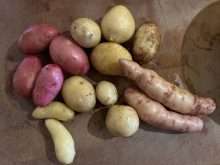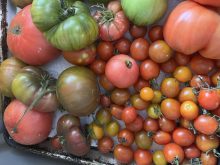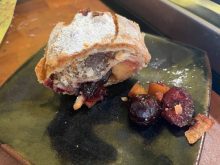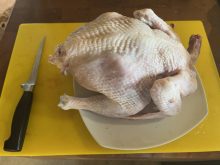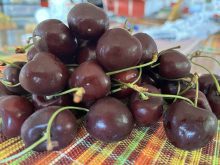As I read Where We Ate by Gabby Peyton, I fell down a rabbit hole of memory. The book, a history of Canadian dining from pre-Confederation to COVID, profiles 150 restaurants by decades. Turns out I have eaten in 26 of them.
“Almost all our restaurant food is immigrant food,” Peyton writes. “We’d be remiss to ignore the social history that makes up our plates, and which is reflected in our restaurants.… The fabric of our collective history is edible… [and] tells the broader story of the country.”
Restaurants have had a special role since my childhood on Vancouver Island. When Dad decreed that we would regularly go out for dinner, it was a big deal — we were as poor as church mice, and meals in restaurants were rare.
Read Also

Gentle treatments for pain in the neck
Heading toward year-end, people unknowingly tense up against the cold and busyness, causing neck pain that can often be treated with appropriate support and gentle mobility, athletic therapist Kathlyn Hossack says.
Not surprisingly, my folks chose cheap n’ cheerful options. For a while, we visited the Chinese restaurants common in the Comox Valley, where my sister and I taught ourselves to eat with chopsticks as we learned to love Asian flavours.
My personal tour of restaurants included by Peyton started as a teen on a trip to Vancouver’s Pacific National Exhibition to compete in pony jumping. My dad took me to The Only in the downtown east side, where I gaped at the rough street scene lit by the blue neon seahorse as I ate my chowder and pan-fried salmon.
A few years later, after we moved to the farm in Saskatchewan where Dave and I now live, movie dates in Saskatoon inevitably ended at Boston Pizza for a pie.
I returned to Vancouver in my early 20s as a cooking student, and my studies were punctuated by frequent foodie forays — for sushi, Indian curries and Chinese dim sum, plus trips to the Afghan Horsemen, and The Naam, where I fell in love with vegetables and a tahini dressing I still remember.
One weekend I undertook a solo bike trip across the straits to Victoria, treating myself to high tea at the Empress Hotel: The women in starched uniforms hustling guests in and out of the lobby reminded me of my great-grandmother, all business, no time for the niceties of smiles.
As a young mother in Calgary, the Silver Inn was a favourite dim sum spot, and we ate our share of Bánh Mi Thi-Thi’s messy-but-yum satay beef subs, perched outside on a bench along the Bow River.
Not far away, River Café opened its locavore doors at the same time I opened my own bistro, and when visiting my in-laws in Toronto my kids ate copious chicken quarters at Swiss Chalet.
As a freelance food writer, I ate beyond the cowboy chutes of my hometown of Calgary: drinking chai and munching pakoras while waiting for a table outside of Vij’s in Vancouver; white tablecloth dining at North 44 in Toronto; in Montreal, wine and frites at L’ Express, smoked meat sandwiches in Schwartz’s steamy dining room, foie gras poutine at Au Pied de Cochon, champagne and local everything at Toqué; Arctic char at Klondike Kate’s in Dawson City; Ches’s fish and chips in St. John’s; strictly local fare at Sooke Harbour House and The Pointe at the Wickaninnish Inn, and food truck tacos at Tacofino on Vancouver Island.
Since my return to Saskatchewan, I have been lucky to eat occasionally at The Star in Maple Creek, Harvest in Shaunavon and Primal in Saskatoon, whose chefs adhere to whole-animal butchery and manage the menu accordingly.
Find them in the pages of Where We Ate, with a smattering of recipes. Some iconic eateries are notable in their absence, and many have gone to the blue-lit streets of restaurant retirement. But there are some where I hope to get my knees under the table before I, too, check out the blue lights of the next world. Until then, first we eat.
Primal’s Beef Heart Bolognese
This classic sauce freezes well, so cook up a full batch. Ideal for stuffed and layered pasta dishes as well as solo on cooked noodles garnished with grated Parmesan cheese.
Vary the sauce by adding mushrooms, red wine, port, diced zucchini, peppers, eggplant or hot chilis to taste. Serves 8–10.
- 3 pounds beef heart or other beef cuts
- 2 pounds pork scrap, prosciutto or bacon
- 1 large carrot
- 3/4 cup whole garlic cloves
- 1 fennel bulb or tops
- 2 large onions, minced
- 1 cup tomato paste
- 1 cup red wine
- 6 cups canned tomatoes, chopped or crushed by hand
- Kosher salt
- 1 1/2 cup milk
- 2 tablespoons butter
- Parmigiano-Reggiano cheese, finely grated, to taste
Grind the meat in a meat grinder and set aside. Grind the carrots, garlic and fennel. Set aside separately.
Sear the meat in small batches in a heavy-bottomed braising pan over medium-high heat. Strain each batch, reserving the fat that drains off. Set the meat aside.
Return the fat to the pan and sauté vegetables over medium heat until golden. Add tomato paste and cook for five minutes.
Deglaze the pan with the wine, cook for several minutes, then add the meat and tomatoes. Reduce heat to low and simmer for an hour. Season to taste.
Stir in the milk, butter and cheese. Bring to a simmer and add cooked pasta of your choice. Serve immediately.




